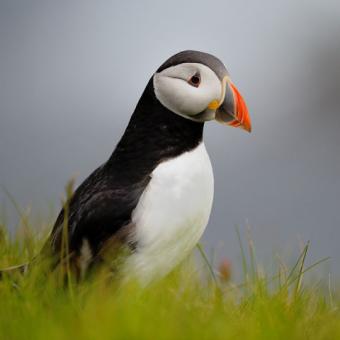Activity Level 2: Easy-Moderate
This journey has a cultural and geologic focus, with an emphasis on the impact of climate change on Iceland—and the larger world. The trip is moderately paced, visiting five different locations over ten days, with four one-night stays. There are no strenuous activities, but there are daily walks, sometimes over sandy, gravelly, and icy or slippery paths; and periods where you can expect to be on your feet for one to six hours, with rests. There is one whale watch aboard a small vessel where you may get wet; plus a boat tour in the Jökulsárlón Glacial Lagoon. The best season to travel is late spring/summer (May–September), when daily high temperatures in Reykjavik range between 49˚–58˚F, with cooler temperatures prevailing in the evenings and more northerly locations. Most travel takes place overland aboard private motorcoaches, with the longest scenic drive lasting about 5 hours. There is one internal flight.
Entry & Exit Requirements
U.S. and Canadian citizens must have a passport valid at least three months beyond your planned date of departure from Iceland. As this requirement is subject to change without notice, we recommend at least six months' validity.
A visa is not required for visits up to 90 days.
If you are not traveling with a U.S. passport, please check with the Icelandic Embassy for the requirements based on your nationality.
Health Information
IMMUNIZATIONS
The Centers for Disease Control recommends that all travelers be up to date on routine vaccinations such as measles-mumps-rubella (MMR) vaccine, diphtheria-pertussis-tetanus vaccine, varicella (chicken pox) vaccine, and your yearly flu shot before every trip.
There are no vaccinations required for entry into Iceland.
Some physicians recommend that travelers get a hepatitis A vaccine before visiting Iceland.
Please consult your physician for additional information and recommendations based on your individual circumstances.
FROSTBITE
Frostbite is damage to the skin from freezing and is due to prolonged exposure to cold temperatures. Symptoms include patches of reddened skin that become white, hard, and swollen; or skin that burns, tingles, or is numb or painful. Severe cases can result in blisters or ulcers forming and may involve deeper tissues. The most common sites for frostbite are the fingers, hands, toes, feet, ears, nose, and cheeks.
To avoid frostbite, dress warmly and in layers but avoid tight clothing as it may reduce circulation. Keep the face and extremities covered. Avoid overheating and excessive perspiration. Change wet clothing, especially socks and gloves.
HYPOTHERMIA
Hypothermia is life threatening. It is caused by cold, wet, or windy weather that causes the body to lose heat faster than it can produce heat. Hypothermia can occur in rugged mountain terrain where the weather can change extremely fast, or after being soaked in a stream crossing or a boating accident since most Alaskan waters are very cold all year long.
Symptoms include feeling cold, uncontrollable shivering, clumsiness due to loss of muscle coordination, slurred speech, inability to think clearly, and eventual unconsciousness and cessation of reflexes including heart and lung functions. Many victims in the later stages of hypothermia feel warm and try to shed clothing.
To treat hypothermia, first warm the core of the body before the extremities. Remove any wet clothing. Re-warm the victim slowly; do not warm fast by immersing in warm/hot water. Provide shelter out of the weather. Warm drinks are not necessary, but may help in the psychological recovery. Do NOT give alcohol. Try to keep victim awake as this helps keep the body temperature up.
SUN EXPOSURE
Despite cold temperatures, the effects of the sun can be damaging to the eyes and skin. Spending time outdoors exposes you to the sun’s harmful ultraviolet (UV) rays, even on cloudy days. To protect yourself from the sun, use a broad spectrum sunscreen of at least SPF 15, protect skin with clothing, wear a wide-brimmed hat and sunglasses, and drink plenty of fluids.











